Tips & Tricks to Make Your Motorcycle Camping More Enjoyable
Start your engines and get ready for the ultimate adventure! A popular local expression is “the journey is the destination,” and that couldn’t be more true when it comes to motorcycle camping. Whether you’re a seasoned pro or a beginner, there are so many places to explore and sights to see when you hit the open road on two wheels.
From winding mountain roads and rugged coastlines to vast deserts and lush forests, motorcycle camping is an exciting way to explore the great outdoors and experience the freedom of the open road.
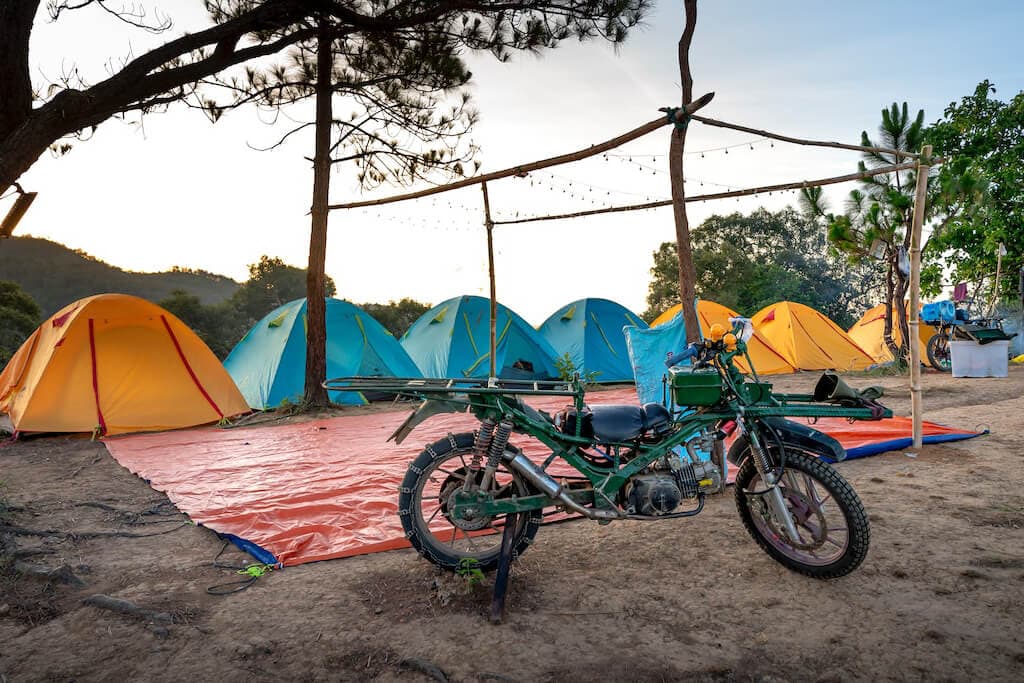
So pack your saddlebags, grab your tent, and get ready for an unforgettable journey as we’ll go through some motorcycle camping tips and gear, from helpful hints to absolute must-haves. Let’s get you on the road to a great motorcycle camping adventure.
Why Motorcycle Camping?
Whether you’re looking for a weekend getaway or an extended motorcycle tour, motorcycle camping is the perfect way to explore the open road. There’s nothing quite like the feeling of freedom that comes from rolling down the highway with all your gear strapped to your bike. Plus, when you camp on a motorcycle, you get to experience the local culture and scenery in a unique way. And, as the locals say, “Ain’t nothing like sleeping under the stars!”
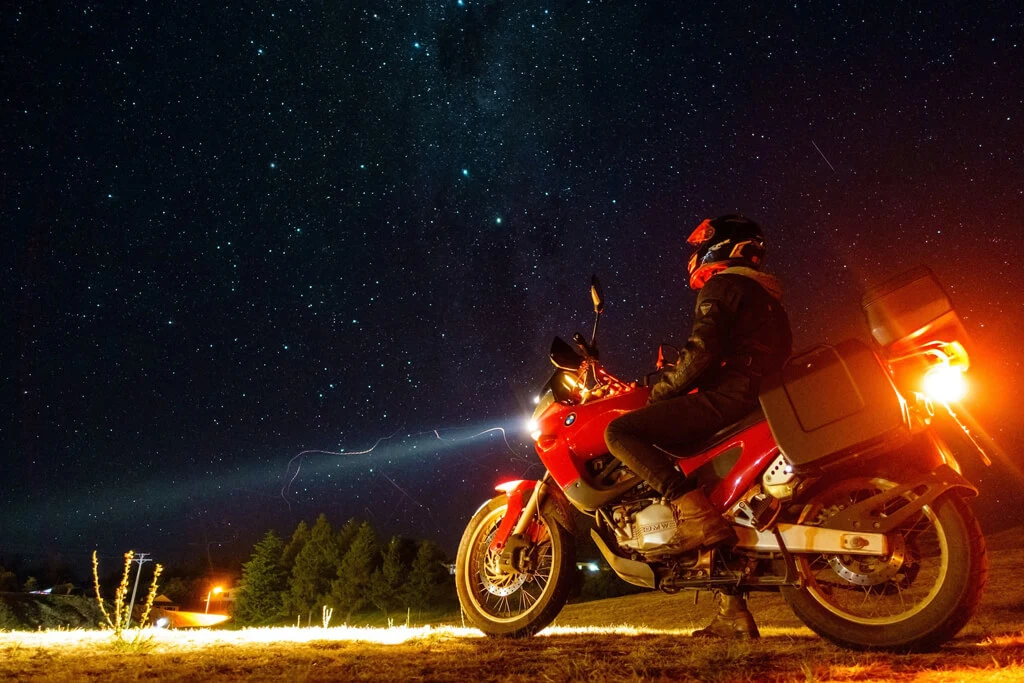
Motorcycle camping is a great way to explore places that are inaccessible by car or RV. You can take winding roads through scenic mountain passes and find yourself in places only accessible by dirt roads or trails. You can also take advantage of backcountry campsites that may have been overlooked by traditional campers.
The best part about camping on a motorcycle is that you can save money on accommodation, leaving more money to fill your tank; You don’t have to spend hundreds of pounds on a hotel room, worry about finding a parking space, or lug your gear up and down countless flights of stairs. These are all reasons why motorcycle camping is so attractive.
Motorcycle Camping Plans
Your plans for your motorcycle camping trip will determine the amount of preparation required. There are a few things you need to consider before you go. Planning is everything! Carefully consider the following questions.
Where will you stay for motorcycle camping?
Official list of motorcycle camping sites
For a nominal fee, you can usually find adjacent facilities, security, running water, restrooms, and electricity at campgrounds on the official list. Because of their efficient setup and management, these campgrounds are easy to discover throughout the United States, Canada, Australia, New Zealand, the United Kingdom and other countries. These campgrounds offer a number of benefits, such as easy access to beautiful trails and routes, easy motorcycle parking and storage, and a sense of community among other riders.
However, the price range is wide, and in some regions of Europe, prices are comparable to a budget hotel. By comparison, in countries like Japan, there are thousands of official campsites that are free and constantly populated by friendly riders.
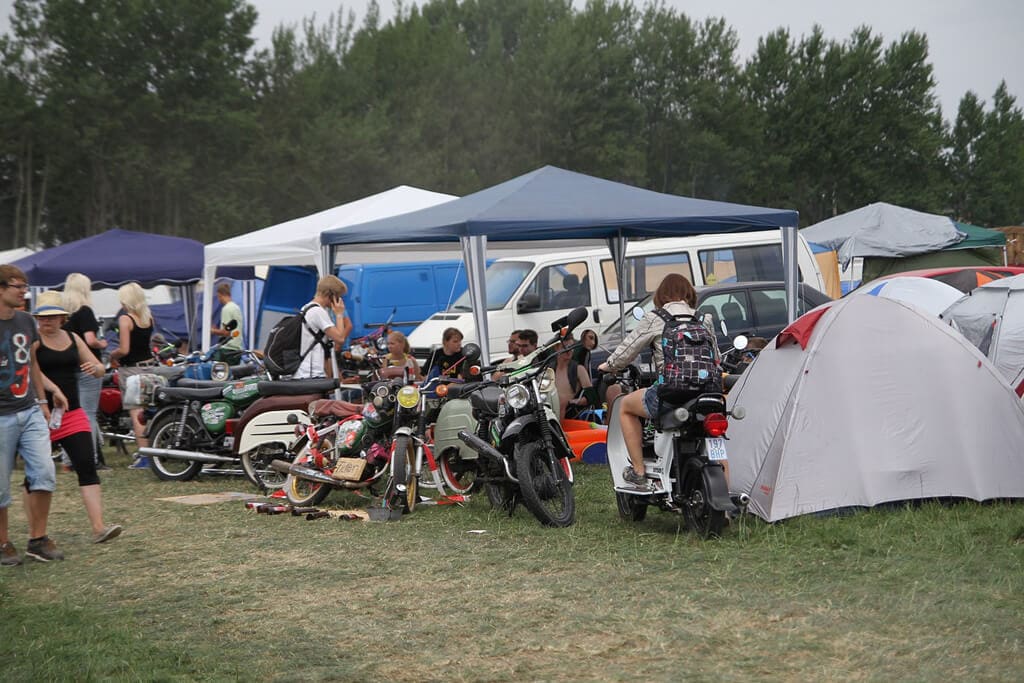
It’s a good idea to stay at an official campground if you’re traveling by motorcycle or have a limited amount of time, so you don’t waste it trying to find a place to stay every night.
For those who really want to get in touch with nature, or for long-distance riders who don’t plan to travel in countries with many official campgrounds, wilderness camping is the way to go.
Wilderness Camping with a Motorcycle
Camping in the wilderness simply means that you can do it anywhere. Before you go camping, make sure you understand the local regulations. For example, it is allowed in Scotland and the USA, but not in England or Australia. You may be able to go to Asia, where most countries are fine. Make sure you are not breaking any laws by checking first.

The most important thing to keep in mind is to be respectful, to ask permission if it’s obviously someone else’s property, to stay out of people’s way, and to leave no trace of your presence.
Motorcycle wild camping is a necessary part of motorcycle travel. It’s also a lot of fun and gets easier with practice. The hard part is finding a place to pitch your tent. You have two choices:
Hide to view
Finding a river on your map or GPS and heading for it is the best and often easiest way to go wilderness camping. Being able to use running water for cooking, cleaning, and washing makes a huge difference to a campsite. But avoid setting up too close to standing water, as it attracts mosquitoes. To avoid attracting unwanted attention, try to hide out of the way and off the main trail. If it appears to be private property, see if you can talk to the owner.
In the wild within sight
However, wilderness camping doesn’t always mean traveling through the woods until you find a secluded spot. You can also camp closer to civilization, and the locals usually have no problem with wilderness campers as long as you don’t leave a trail. You can choose to wilderness camp on a farm, in a barn, in an abandoned cabin, in a parking lot, or even in a city park. The most important thing is that the campsite is legally allowed, or the owner will allow it.
By knocking on doors and asking permission to sleep on a patch of grass, these experiences have led to some fantastic evenings and the formation of many friendships. This could be a great wilderness camping option.
How long do you plan to be there?
In addition to where you are camping, the length of your trip is another factor that directly affects your luggage and what you need to bring.
You may think it’s okay to take a few changes of clothes with you and do your laundry when you get back if you’re only going away for a few days. Think carefully about doing your laundry while you travel if your trip will last more than a week. Consider the amount of clothing you’re packing and the frequency of your laundry needs.
Here is my summary of how many pieces of clothing to bring and how often to wash the graphic table:
| How long | Weather | Pack your clothes | Washing frequency |
|---|---|---|---|
| 2 days | Rain | A set of Rain Suit, A set of Long-sleeved underwear &Pants, A set of spring jacket and Pants |
No need |
| Sunny | A set of Long-sleeved underwear &Pants, A set of spring jacket and Pants |
No need | |
| 3-5 days | Rain | A set of Rain Suit, Two sets of Long-sleeved underwear &Pants, A set of spring jacket and Pants |
Only need to wash long-sleeved underwear and pants once |
| Sunny | Two sets of Long-sleeved underwear &Pants, A set of spring jacket and Pants |
||
| Over one week | Rain | a set of Rain Suit, Three sets of Long-sleeved underwear &Pants, Two sets of spring jacket and Pants |
You only need to wash long-sleeved underwear and pants two to three times, and wash jackets and pants once |
| Sunny | Three sets of Long-sleeved underwear &Pants, Two sets of spring jacket and Pants |
| How long | Weather | Pack your clothes | Washing frequency | Note |
|---|---|---|---|---|
| 2 days | Rain | A set of Rain Suit, Two sets of T-shirts & Boxer Briefs, A set of summer Jackets and Air Textile Pants |
Only need to wash T-shirts & Boxer Briefs once | It is recommended that you wear T-shirts & Boxer Briefs made of natural fibers that wick away moisture and do not easily release odor. |
| Sunny | Two sets of T-shirts & Boxer Briefs, A set of summer Jackets and Air Textile Pants |
|||
| 3-5 days | Rain | A set of Rain Suit, Three sets of T-shirts & Boxer Briefs, A set of summer Jackets and Air Textile Pants |
Only need to wash T-shirts & Boxer Briefs two-three times | |
| Sunny | Three sets of T-shirts & Boxer Briefs, A set of summer Jacket and Air Textile Pants |
| How long | Weather | Pack your clothes | Washing frequency | Note |
|---|---|---|---|---|
| 2 days | Rain | A set of Rain Suit, A set of Long-sleeved underwear &Pants, A set of autumn jackets and Pants A set of Sleeveless Jacket or Covert Flannel Shirt |
No need | It is recommended that you wear long-sleeved underwear and pants made of natural fibers that wick away moisture and do not easily release odor. |
| Sunny | A set of Long-sleeved underwear &Pants, A set of autumn jackets and Pants A set of Sleeveless Jacket or Covert Flannel Shirt |
|||
| 3-5 days | Rain | A set of Rain Suit, Two sets of Long-sleeved underwear &Pants, A set of autumn jackets and Pants A set of Sleeveless Jacket or Covert Flannel Shirt |
Only need to wash long-sleeved underwear and pants once | |
| Sunny | Two sets of Long-sleeved underwear &Pants, A set of autumn jackets and Pants A set of Sleeveless Jacket or Covert Flannel Shirt |
|||
| over one week | Rain | A set of Rain Suit, Three sets of Long-sleeved underwear &Pants, A set of autumn jackets and Pants Two sets of Covert Flannel Shirt or a set of Sleeveless Jacket |
You only need to wash long-sleeved underwear and pants two to three times, and wash jackets and pants once |
|
| Sunny | Three sets of Long-sleeved underwear &Pants, A set of autumn jackets and Pants Two sets of Covert Flannel Shirt or a set of Sleeveless Jacket |
| How long | Weather | Pack your clothes | Washing frequency | Note |
|---|---|---|---|---|
| 2 days | Rain or Snowing |
A set of Long-sleeved underwear &Pants A set of Winter Motorcycle Jackets& pants A set of Wool Shirt and extra a set of Goose Down Vest |
No need | It is recommended that you wear long-sleeved underwear and pants made of natural fibers that wick away moisture and do not easily release odor. Since winter motorcycle clothing is waterproof, rain coats are optional. |
| Sunny | ||||
| 3-5 days | Rain or Snowing |
Two sets of Long-sleeved underwear &Pants A set of Winter Motorcycle Jackets& pants A set of Wool Shirt and extra a set of Goose Down Vest |
no need,or Only need to wash long-sleeved underwear and pants once | |
| Sunny | ||||
| over one week | Rain or Snowing |
Three sets of Long-sleeved underwear &Pants A set of Winter Motorcycle Jackets& pants A set of Wool Shirt and extra a set of Goose Down Vest |
You only need to wash long-sleeved underwear and pants two times | |
| Sunny |
Pro Tips: Gloves and helmets are essential for motorcycle riding, and wearing a helmet on a motorcycle is also required by law. To stay in touch with your friends, you can install a Bluetooth intercom on your helmet.
The length of your motorcycle camping trip affects almost everything else, except clothing. Licenses, inspections, and registrations are a few things that have an expiration date. Your choice of accommodation may also vary as a result.
Which gear do you need to bring?
Will you be completely alone in the wilderness or will you be riding to a campground with all the amenities? This is something you should think about.
It is important to spend money on quality motorcycle camping equipment if you plan to spend the night outdoors. Keep in mind that quality gear tends to be smaller, lighter, and more durable.
Tent & Sleeping System
A quality sleeping bag is essential. Down feathers and synthetic fibers are the main competitors, and each has advantages and disadvantages. Although a down sleeping bag is warmer and packs smaller, it does not inflate when it gets wet, which reduces how warm it can keep you. Synthetic sleeping bags dry much faster and are a wonderful option for damp environments, but they take up more space in your pack. Sleeping bag ratings also vary with temperature. A four-season down sleeping bag is rated for temperatures below zero, while the typical three-season synthetic sleeping bag is rated for temperatures as low as 15-20 degrees Fahrenheit.
Then there is the sleeping pad, which plays an important role in warmth and comfort. First of all, avoid taking a giant inflatable mattress when you go motorcycle camping. They are cumbersome and uncomfortably large. An excellent mattress pad will protect you from the heat-trapping ground and should be about the size of a liter bottle of Coke.
Next to the most important tent cannot be forgotten!
A large, family-sized tent with multiple rooms will protect your bike from the elements. The downside is that it can be difficult to pack.
On the other side, a hiking tent is comfortable, protects you from the elements, and can be packed down to the size of a gallon milk jug. The downside is that it’s smaller than a family tent and won’t fit perfectly on your motorcycle.
Motorcycle campers often like small adventure tents because they offer a good compromise between minimal weight and a reasonably large tent.
Sleeping pillows are another great item to get you to enjoy a good night’s sleep. If you rely a lot on your pillow, don’t forget to pack it.
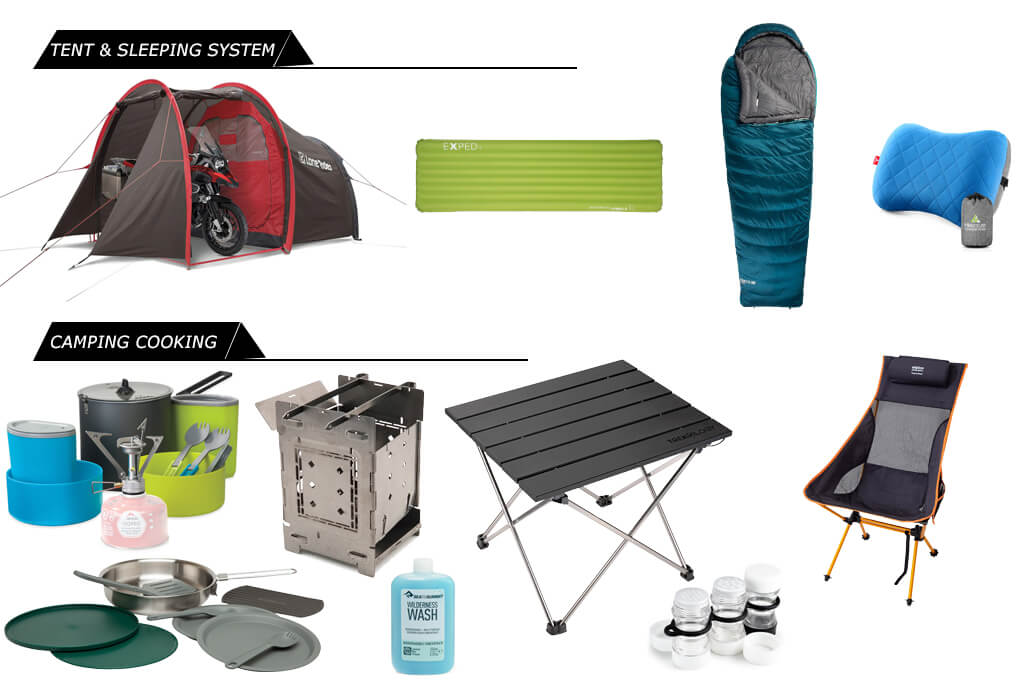
Camping Cooking
Camping Stove
Choose a multi-fuel stove. It comes in a very small package, is lightweight, and is easy to refill because it uses gasoline (or diesel). Or you can choose a firebox stove, which is collapsible (when you’re done using it, just fold it flat and slide it into your backpack) and is also able to utilize wood and other fuels found in nature.
Pots and Pans other gear
Since there is no other way to get smaller, lighter, and more compact pots and pans, it is better to pay a little more when purchasing cooking equipment. The cheaper materials rust faster, require more time to clean in the morning and at night, are heavier, and cost more to replace in the long run. If you cook almost every day, you should choose better quality pots and pans – it will pay off for you. For solo travelers, there are one-man options. And remember to pack some sturdy yet lightweight plastic utensils.
You’ll also need a good knife, bowl, dishcloth, sponge, dish soap, and a small cutting board for cooking. It’s worth bringing a small waterproof container with your favorite spices, salt, pepper, and sugar if you like to flavor.
You will also need something to put the food in and sit on while you get ready and eat. You can choose to use your luggage (it is a hassle and uncomfortable to unpack from your bike every time), you can also choose a lightweight camping table (foldable), camping chairs are also very necessary and having them will definitely make you more comfortable.
Camping food
The right food has to be packed for motorcycle camping. You need food that is easy to prepare, portable, and has a long shelf life. In other words, you need to strike a balance between nutritional content, mobility, and shelf life. Here is a camping breakfast menu.
You can make camping food such as “beef jerky,” “trail mix,” “granola bars,” and “pemmican”.
Beef jerky is a popular snack for bikers due to its high protein content, long shelf-life, and ease of storage. Trail mix is also a favorite, providing a quick energy boost from the combination of nuts, dried fruit, and chocolate. Granola bars are another good option as they are easy to pack and provide a satisfying mix of carbohydrates and protein.
If you’re looking for something heartier, consider bringing a can of soup or chili. Because they don’t need refrigeration and have a long shelf life, canned goods are a fantastic option. You can also bring items such as instant oatmeal, pasta, and dried meals that can be quickly cooked with just hot water.
You can also pack ingredients for a hot breakfast or dinner, such as eggs, bacon, and vegetables, if you have space for a small campfire or grill. Just be sure to pack them properly in a cooler or insulated bag.
In most cases, lightweight, easy-to-prepare, and long-lasting foods such as beef jerky, trail mix, granola bars, canned goods, and dried meals are the best options for motorcycle camping.
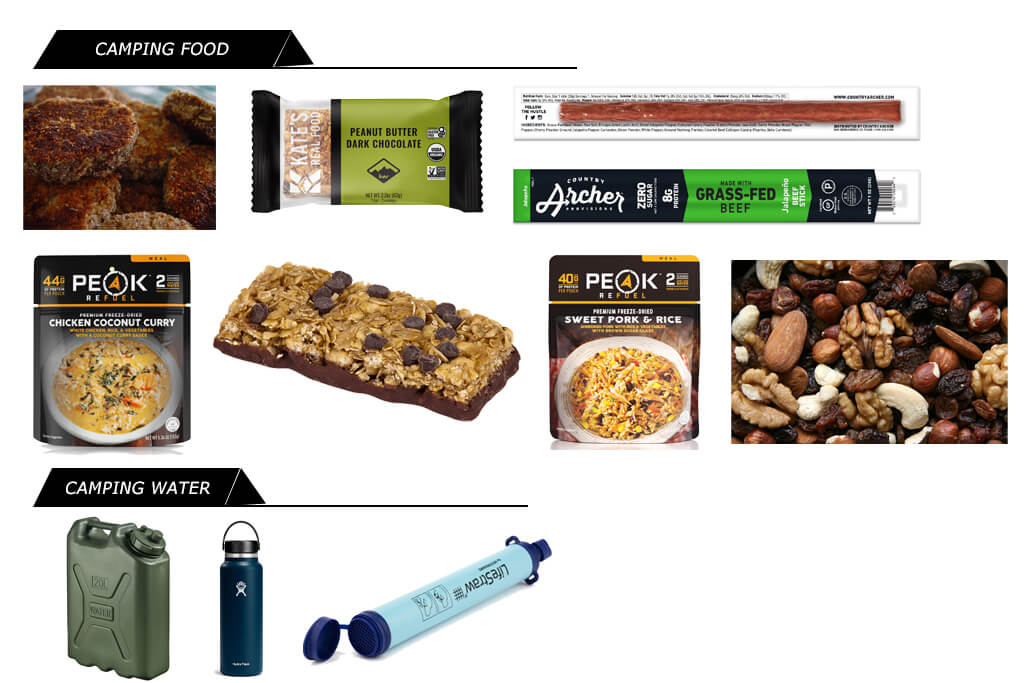
Camping water
Another important factor is water, and an investment in a durable water bottle that can withstand the rigors of motorcycle travel is a wise choice. A popular option is a stainless steel water bottle, which is not only durable, but also keeps water cool during the hot summer months. It’s also good to carry a large water tank with which you can cook, wash dishes, drink water, make coffee, take a shower, etc. It’s also important to bring a water filtration system with you, as untreated water can contain harmful bacteria and parasites.
In terms of how much water you should drink each day, it’s recommended that you drink at least 2-3 liters (0.5-0.8 gallons), more in hot weather or when exercising. Rather than waiting until you’re really thirsty and drinking a large amount of water all at once, it’s better to drink water in smaller amounts on a regular basis. To avoid dehydration, it’s also important to drink water before, during, and after exercise.
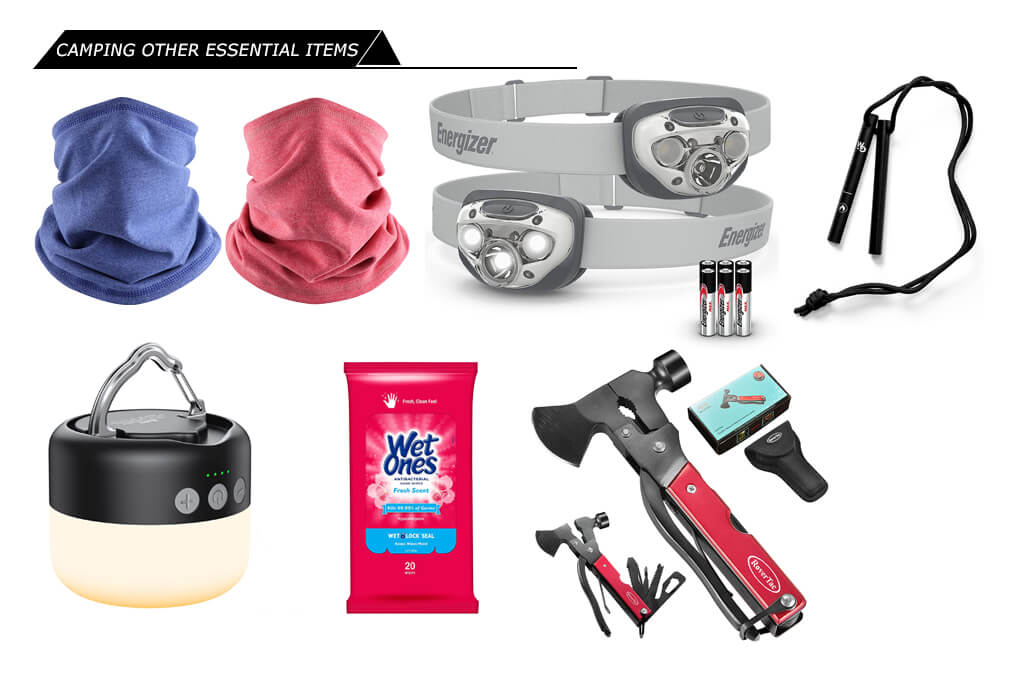
Other essential items
Neck Scarf – Most motorcyclists travel with a neck scarf. They also serve as a hat when camping in cool weather, a logical choice as opposed to bringing a wool hat.
Headlamp – The most important addition is this. It is much more convenient than a hand torch because it makes it easy to move, cook, and go to the bathroom in the middle of the night.
Lamp – When camping, a compact but powerful lantern makes life so much easier. When it’s time to crawl into your sleeping bag, it can hang inside your tent and light up your campsite.
Wet Wipes – You shouldn’t be wasting your drinking water on something as trivial as cleaning your smelly armpits! Your need for a shower is sorted by the wet wipe.
Fire Starters – We all have matches or a lighter to get us through the day. But let’s face it – using one to light a fire just seems nice. But seriously, you’ll be glad you have this when your matches get wet.
When creating your own checklist, try to be as specific as possible about the items you actually need and plan to use. Lets you spread out your prepared items on the living room floor and also makes it easy for you to take inventory of your items. However, this may still not be the best solution. So the ideal strategy is to take a few small weekend trips. You’ll quickly become aware of what you need and what you don’t.
How to pack for motorcycle camping
It’s not the same as packing a bag and leaving the house when you go camping on a motorcycle. What you carry on a motorcycle becomes an integral part of the adventure. Consider alternative ways to carry your luggage on your bike instead of using an average suitcase, which adds weight, wind resistance.
Now let’s discuss the ideal motorcycle packing strategy for a camping vacation.
1.Choose luggage made for motorcycles
You can choose Overlander luggage, The semi-rigid bottom allows it to keep its shape. It has practical straps to carry it as a backpack. The Beavertail on the Overlander is a great place to store extra clothing for changing temperatures, hydration packs, and maps.
2.Close attention to weight distribution
Almost any type of vehicle will be stable if it has a low center of gravity. This is especially true for motorcycles, as the rider must balance the machine with one foot when stopping at a red light. A motorcycle must also have a sufficiently even distribution of weight over its tires. If there is too much weight on the back axle, the front tire will lift, which can drastically affect steering and stability. Concentrate on keeping the weight close to the motorcycle’s center of gravity to maintain a safe ride.
Place your heaviest items in the trunk first. They should be placed between the two wheels, low on the bike, with the typical location being directly in front of the rear tire. They should also be evenly distributed and packed on both sides of the bike to avoid uneven pull on one side or the other.
Pack light items higher up and behind the rider or passenger. This will move them out of the wind’s path and won’t change the weight distribution from front to rear, provided they’re not too heavy.
There are several tools available to help you pack your motorcycle. An excellent place to start is with a luggage rack. This small platform, usually mounted over the back of the bike behind the axle, gives you a place to place and secure your smaller luggage. Then there are saddlebags or straps that allow you to attach luggage to the sides of your bike. Just be careful not to block the engine’s air intake or attach your bag to an area of the bike that can heat up during use.
3.Have a saddle bag for dirty or wet clothes
No matter how carefully you fold and pack your clothes, you don’t want them to mix with your clean clothes once they get dirty. This often ruins your meticulous packing strategy, as dirty and damp clothes end up in the wrong places. You’ll have a lot less stress if you prepare ahead of time for your dirty clothes.
Set aside a saddlebag for your wet or dirty clothes while you get ready for your motorcycle camping vacation. Put a few packets of laundry detergent in a plastic bag and place it in this compartment as well. Take the entire saddle bag with you to the laundromat when it’s time to do laundry.
Where to set up camp
Before choosing a place to camp, look for warning signs such as animals or flooding; make sure you are not on an old trail by looking for car tracks on the ground; avoid standing water because of mosquitoes; choose areas with trees because you will have more firewood, more protection from the elements, and more privacy; if you must camp outdoors, try to find a large, immovable object, such as a boulder, to camp next to because it will act as a wind break.

When to pitch a tent
When camping, try to leave early. If you’re wild camping, you want to allow time to find a site, set up and cook. Finding a site in the dark is the last thing you want to do. Cooking in the dark is also difficult, as your food will only taste of the flying insects attracted by your headlamp. Prepare everything beforehand, eat before dark, and then spend the evening by a fire.
When setting up your tent, try to keep it in a dry place. Also, do not park your motorcycle in a place where it can easily be blown over by the wind and fall on your tent. Your motorcycle should always be leaned away from your tent.
Finding the Best Motorcycle Campsites for Overnight Stays
One of the best motorcycle campsites in the USA is Moto Camp Natchez Trace. Located in Tennessee, this site offers a variety of camping options, including cabins and tent camping. The site is also conveniently located near the Natchez Trace Parkway, a popular scenic route for motorcyclists.
The Canadian Motorbike Tourist Association (CMTA) in Canada has a list of campgrounds that welcome motorcycles. British Columbia’s Horne Lake RV Park and Campground is one of the best choices on the list. This location offers both stunning scenery and amenities like fire pits and hot tubs.
In Japan, the Yokote Yume no Kaze Motorbike Campsite, located in the beautiful Akita Prefecture, is a notable location. Along with hot springs and other facilities, the site offers a designated area for motorcyclists.
Tips & Tricks to Make Your Motorcycling Adventure More Enjoyable
1. Bring only what you need
This is easy in theory, but challenging in practice. But with a little imagination, you’ll get the hang of it. You will inevitably have to make some sacrifices and compromises to bring only what you need, but trust that it will be worth it. There are many things you don’t need to pack from home when you travel because you have access to them.
Check that everything you bring has at least two uses. For example, carry fleece long-sleeved shirts for fall and winter rides that you can wear both during the day and for sleeping at night. Your pot can be used to cook food and serve food. That means you don’t even need to bring a bowl for eating.
2. Consult Early Weather Research
This is critical for safety, as mentioned above, but it also makes packing much more effective. If it rains heavily during the camping week, you may want to postpone your camping plans or go from wilderness camping to a formal campground with full facilities. Bring clothing and change according to the temperature!
3.Plan how to do the laundry
If you are camping in the wilderness and there are no laundries or laundry facilities nearby, you will need to do your own laundry. It is a good idea to bring a small bag or bottle of laundry detergent with you. Of course, if you’re at a well-equipped campground, there may be laundry facilities nearby so you don’t have to do your own laundry.
Remember that reducing the number of changes of clothing you need to bring can help you pack more efficiently.
4.Pick up lightweight backpack and camping gear
Just as lightweight camping gear is undoubtedly of superior quality, it will also make packing easier for you. A large tent shouldn’t be attached to the side of your bag. The same goes for cookware; lightweight models designed for motorcycle camping can help you pack lighter. These items will last you many years if you take good care of them.
5.Staying warm
In some cities, the days are hot, but the nights are cold. Since your head loses the most heat when you sleep, a woolly hat or your cycling snood/scarf can be a big help. Place clothing in the bottom of your bag so that it will be warm in the morning.
6. Protection against animal attacks or insect bites
The most important thing when camping in the wilderness is to prevent animals from visiting your campsite at night, as well as insect bites. You should carry insect repellent or mosquito repellent to keep these bugs away from you.
If you are worried about animals visiting your campsite at night, you can build a campfire and leave it burning overnight (make sure the campfire does not burn the surrounding trees and plants). And make a barrier (with thorny trees) within 2 meters of your tent.
Be careful with your food, too. You may have to hang your food from a tree, but at least keep it in an airtight Ziploc bag.
Pro tips:Putting your socks over the opening of your boots creates a cover to keep scorpions and other pesky creatures out.
No matter where you plan to ride and camp, it’s important to do your research and choose a site that caters to motorcyclists. With a bit of planning, you can enjoy a memorable motorcycle camping adventure at some of the best campsites in the world.
Do you have any motorcycle camping ideas?Don’t be stingy with your thoughts, just let us know in the comments.
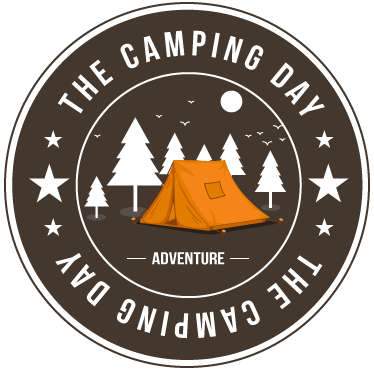
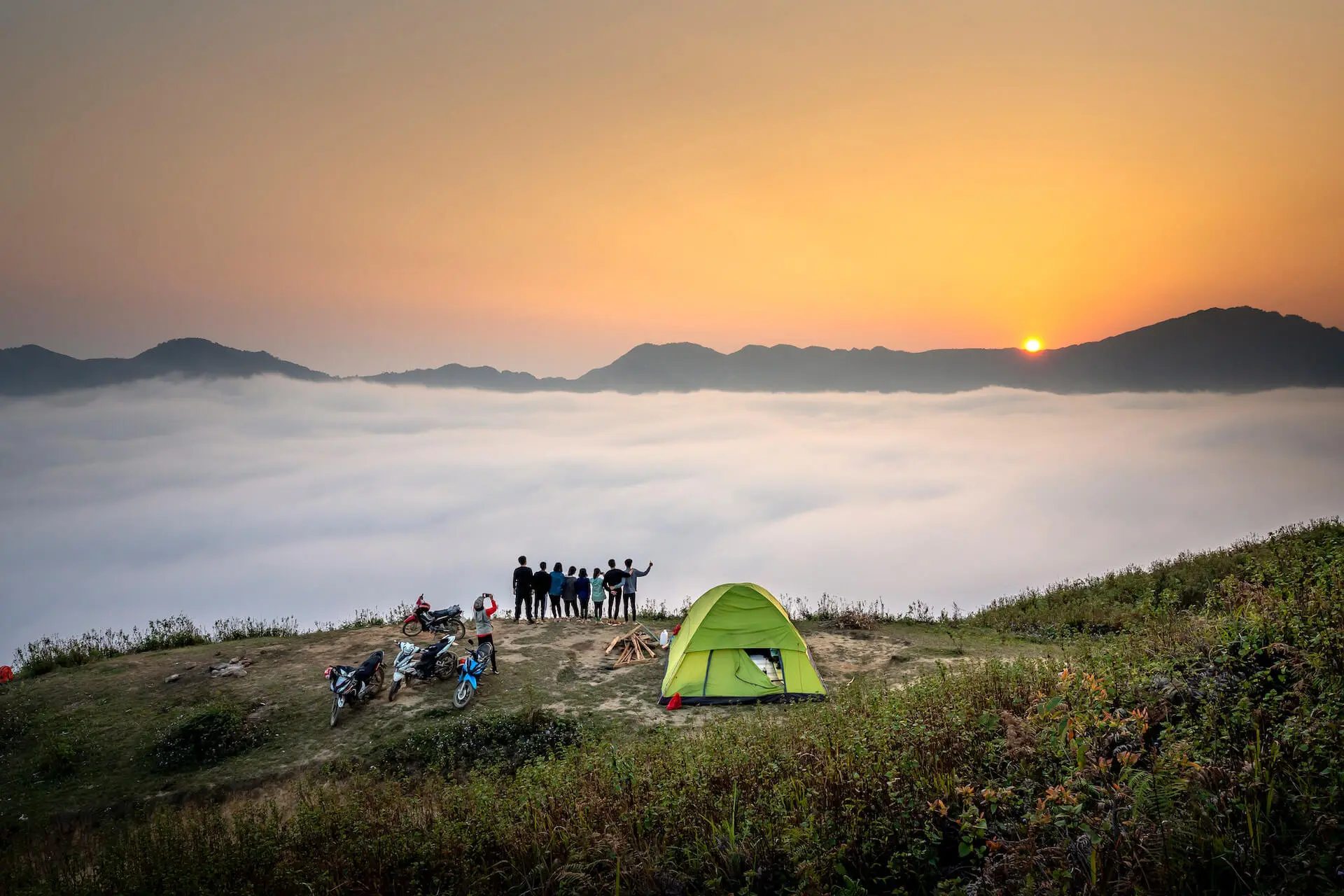
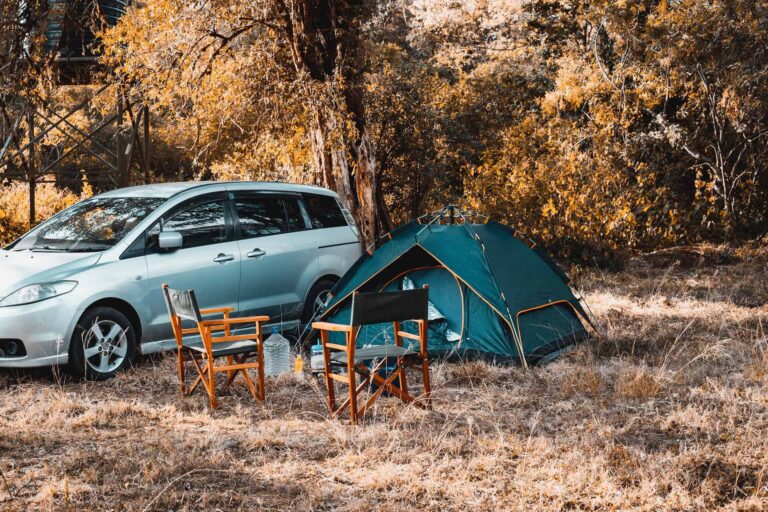
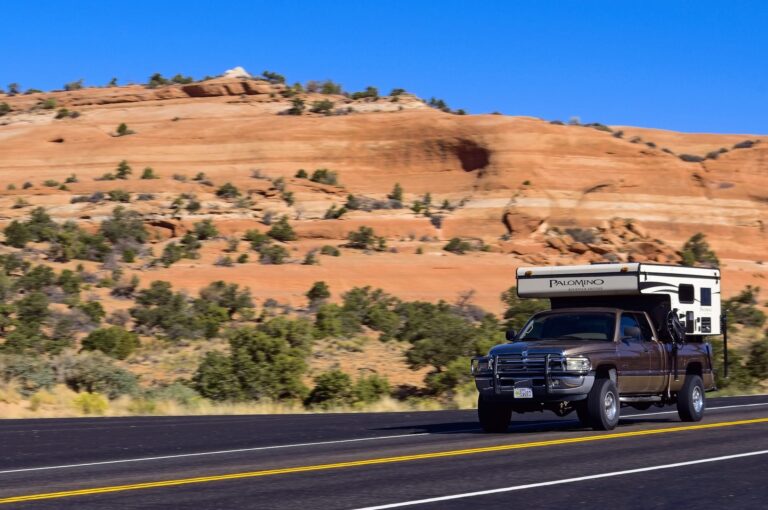
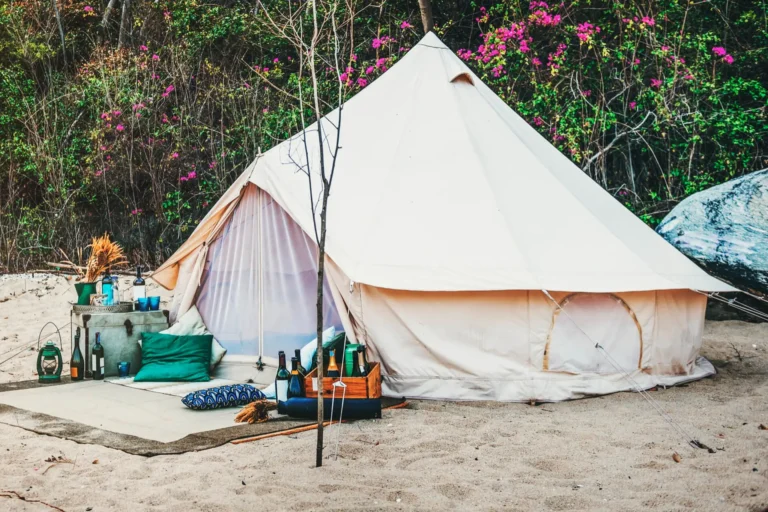
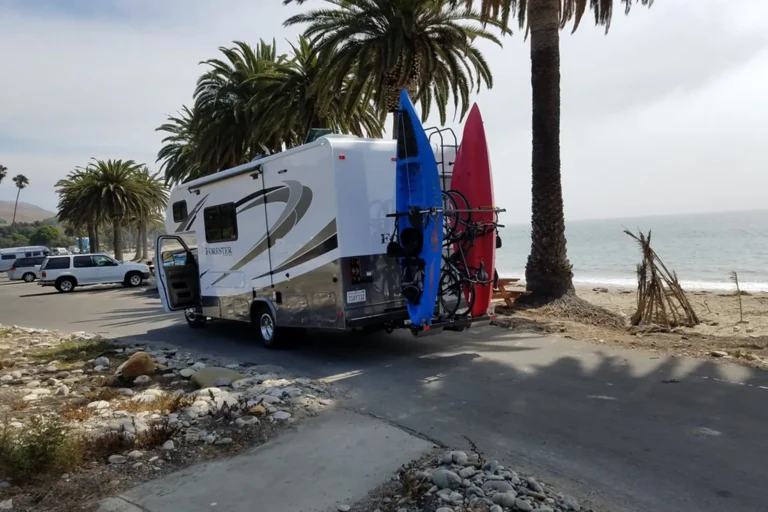
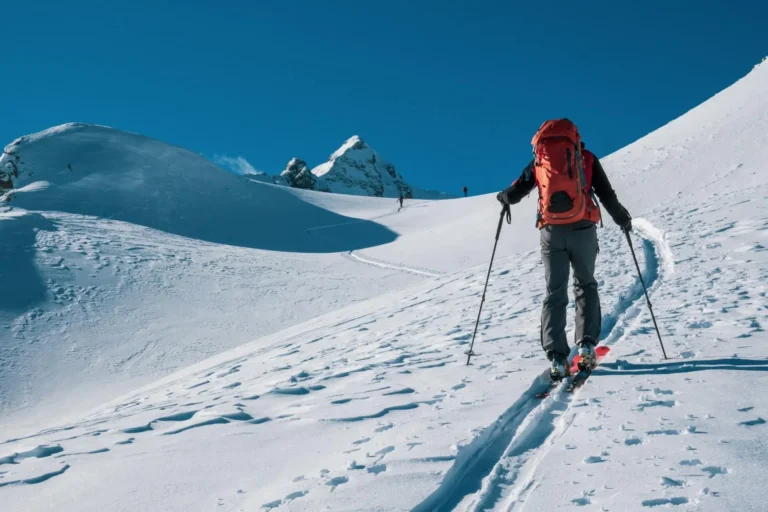
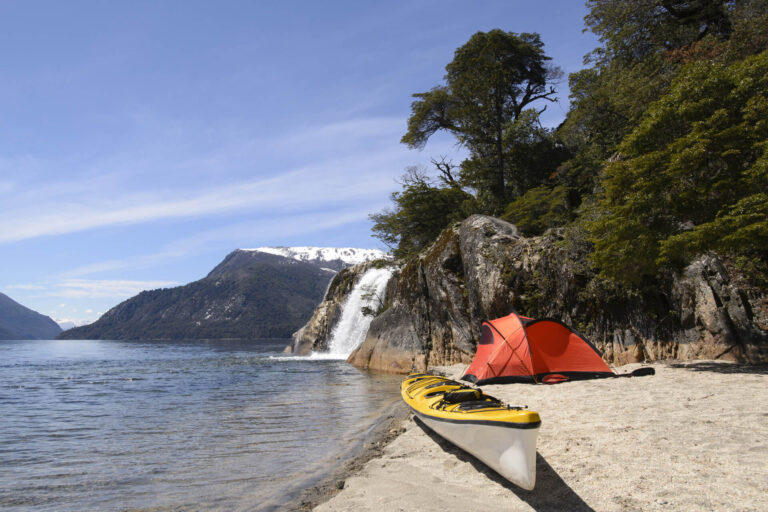
Hello, I’m Wahab, an experienced camper and blogger. Your article provides an incredible set of tips that even seasoned campers like me find incredibly valuable. Your insights elevate the camping experience for all of us. Thank you for sharing such insightful tips!
THANK YOU SO MUCH!